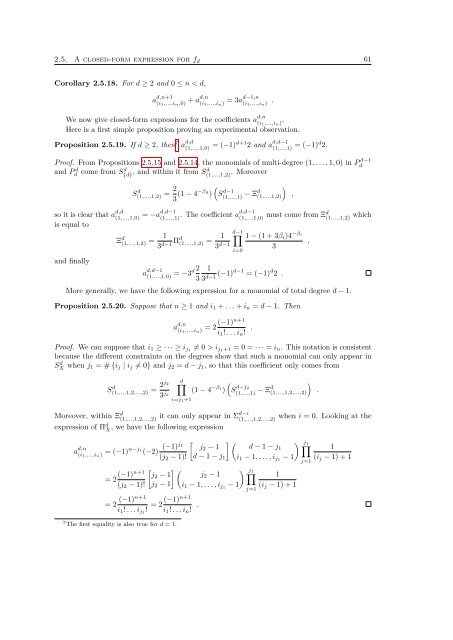here - Sites personnels de TELECOM ParisTech - Télécom ParisTech
here - Sites personnels de TELECOM ParisTech - Télécom ParisTech
here - Sites personnels de TELECOM ParisTech - Télécom ParisTech
Create successful ePaper yourself
Turn your PDF publications into a flip-book with our unique Google optimized e-Paper software.
2.5. A closed-form expression for f d 61Corollary 2.5.18. For d ≥ 2 and 0 ≤ n < d,a d,n+1(i 1,...,i n,0) + ad,n (i 1,...,i n) = 3ad−1,n (i 1,...,i n) .We now give closed-form expressions for the coefficients a d,n(i 1,...,i n) .Here is a first simple proposition proving an experimental observation.Proposition 2.5.19. If d ≥ 2, then 7 a d,d(1,...,1,0) = (−1)d+1 2 and a d,d−1(1,...,1) = (−1)d 2.Proof. From Propositions 2.5.15 and 2.5.14, the monomials of multi-<strong>de</strong>gree (1, . . . , 1, 0) in P d−1dand P d d come from Sd {d} , and within it from Sd (1,...,1,2) . MoreoverS(1,...,1,2) d = 2 ()3 (1 − 4−β d) S d−1(1,...,1) − Ξd (1,...,1,2)so it is clear that a d,d(1,...,1,0) = −ad,d−1 (1,...,1). The coefficient ad,d−1(1,...,1,0) must come from Ξd (1,...,1,2) whichis equal toΞ d (1,...,1,2) = 13 d−1 Πd (1,...,1,2) = 1d−1∏ 1 − (1 + 3β i )4 −βi3 d−1 ,3and finallya d,d−1i=0(1,...,1,0) = 2 1−3d 3 3 d−1 (−1)d−1 = (−1) d 2 .More generally, we have the following expression for a monomial of total <strong>de</strong>gree d − 1.Proposition 2.5.20. Suppose that n ≥ 1 and i 1 + . . . + i n = d − 1. Then,a d,n(i 1,...,i n) = 2 (−1)n+1i 1 ! . . . i n !.Proof. We can suppose that i 1 ≥ · · · ≥ i j1 ≠ 0 > i j1+1 = 0 = · · · = i n . This notation is consistentbecause the different constraints on the <strong>de</strong>grees show that such a monomial can only appear inSX d when j 1 = # {i j | i j ≠ 0} and j 2 = d − j 1 , so that this coefficient only comes fromS d (1,...,1,2,...,2) = 2j23 j2 d∏i=j 1+1((1 − 4 −βi ) S d−j2(1,...,1) − Ξd (1,...,1,2,...,2)).Moreover, within Ξ d (1,...,1,2,...,2)it can only appear in Σd−i(1,...,1,2,...,2)when i = 0. Looking at theexpression of Π d X , we have the following expression[ ] (a d,n(i = 1,...,i n) (−1)n−j1 (−2) (−1)j1 j2 − 1 d − 1 − j 1(j 2 − 1)! d − 1 − j 1 i 1 − 1, . . . , i j1 − 1= 2 (−1)n+1(j 2 − 1)![ ] (j2 − 1j 2 − 1= 2 (−1)n+1i 1 ! . . . i j1 ! = 2 (−1)n+1i 1 ! . . . i n !7 The first equality is also true for d = 1.j 2 − 1i 1 − 1, . . . , i j1 − 1.) j1∏j=11(i j − 1) + 1) j1∏j=11(i j − 1) + 1
















